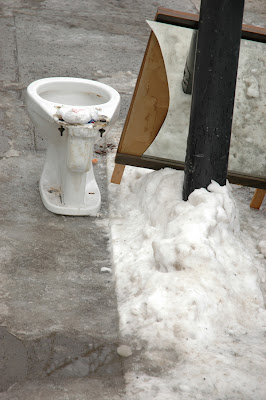
Description: Found art items that were discarded on the sidewalk really intrigued me. The snow that reflected in the mirror contained more detail than the 'actual' snow gathered around the light pole.
Intentions: To disrupt the viewer's definition of what is art- I'm following in DuChamp's greatly grooved path of finding everyday objects and seeing them as extraordinary and worthy of archiving in a photograph.
Good/Bad: The monochromatic colours within this image almost make it a black and white- except for the wood backing for the mirror which is showing, due to some careless or violent actions that lead this mirror and toilet to be discarded for the endless heap of unwanted consumption we term, a 'dump.' My point of view or vantage point could have been heightened in intrigue. Now that I see the framed image I'd want to re-shoot with my back or front on the ground looking upwards at the toilet and mirror to make them larger than life, and possibly catch my reflection in it's surface to add tension to make the shot more interesting.
Evaluation: The image is a bit bland and washed out due to the high presence of midtones, so I've included this secondary image which has more contrast and tension around the stains of the toilet and the stained snow behind the abandoned bowl- gross! Also, the brown mucky water in the street's gutter, behind the bowl, is reminiscent of toilet refuse and junkyard rain water as it collects and molds around the discarded 'gems and jewels.'


One person's trash is another person's beauty. This bird died... how? Was it a car, a window, the cast iron fence I found it laying in front of, or an animal that got at it's neck... who knows, it was there for only 2-3 days before I suspect some local dog had a nice snack!











